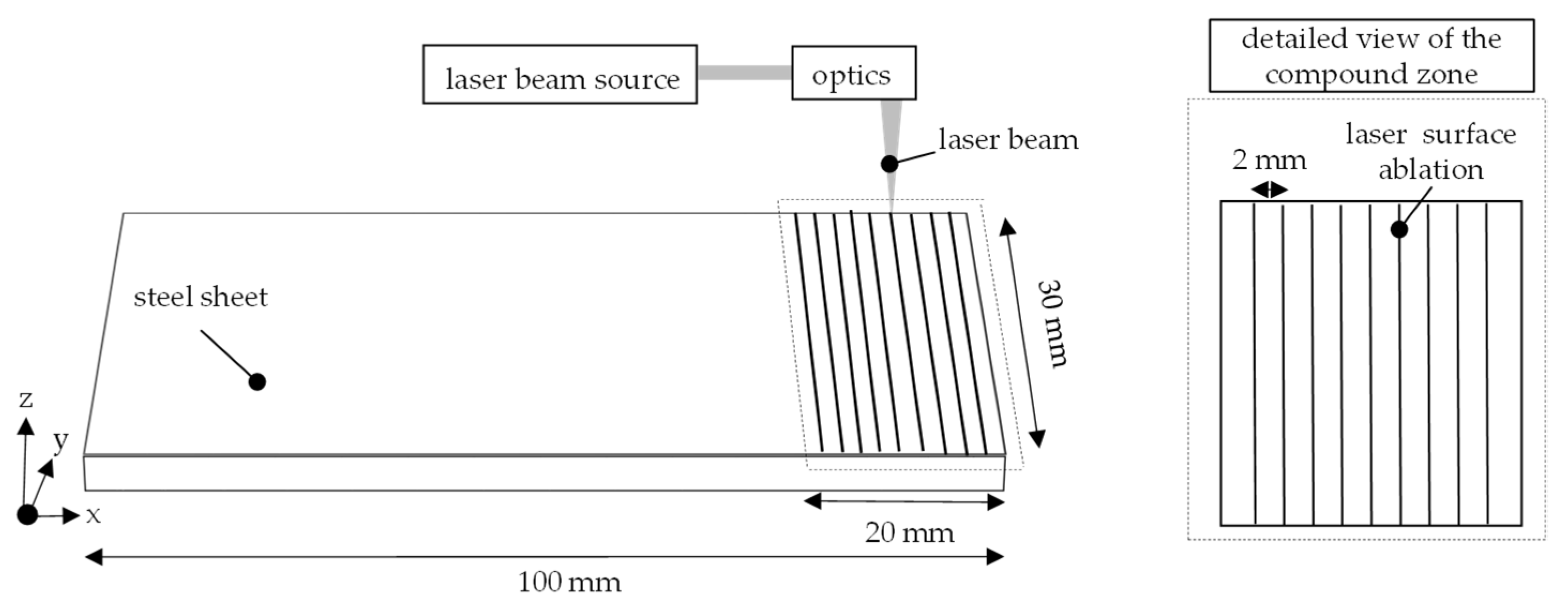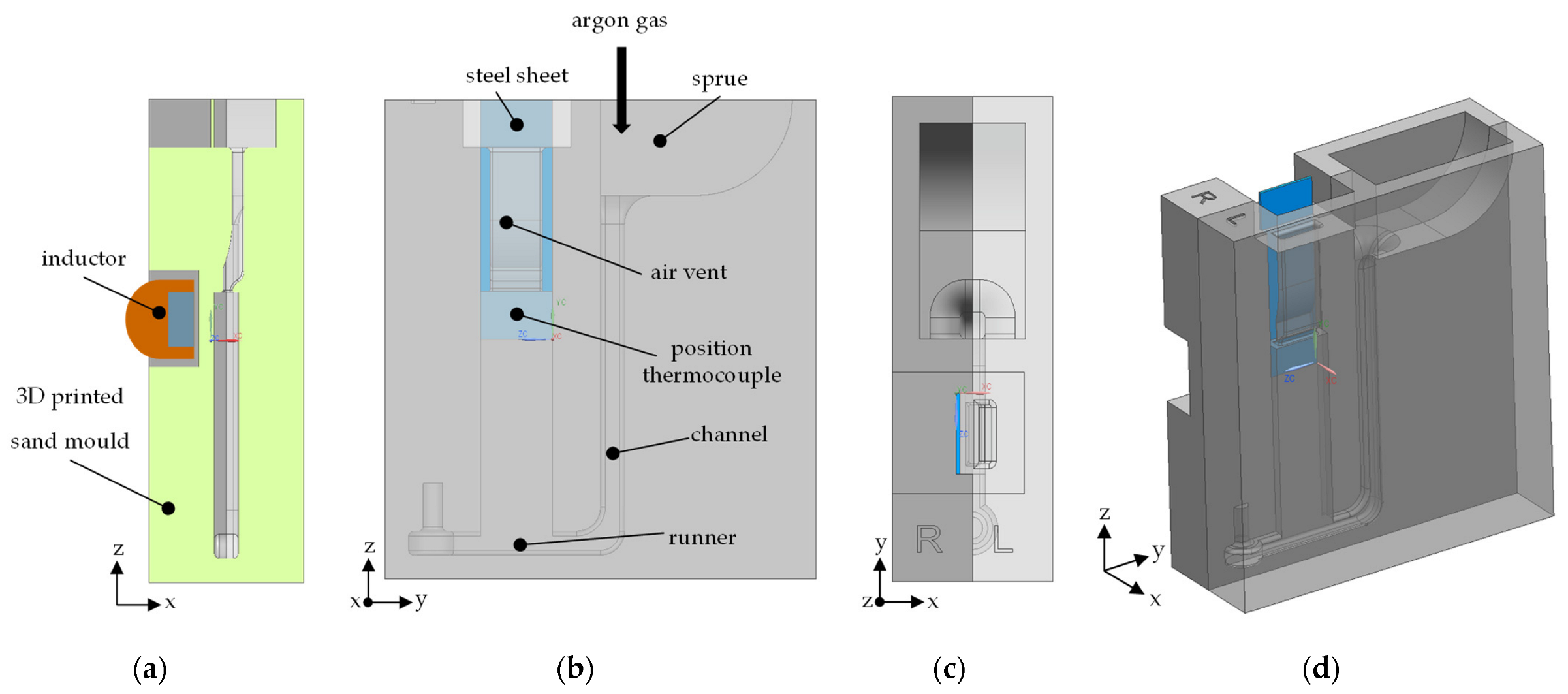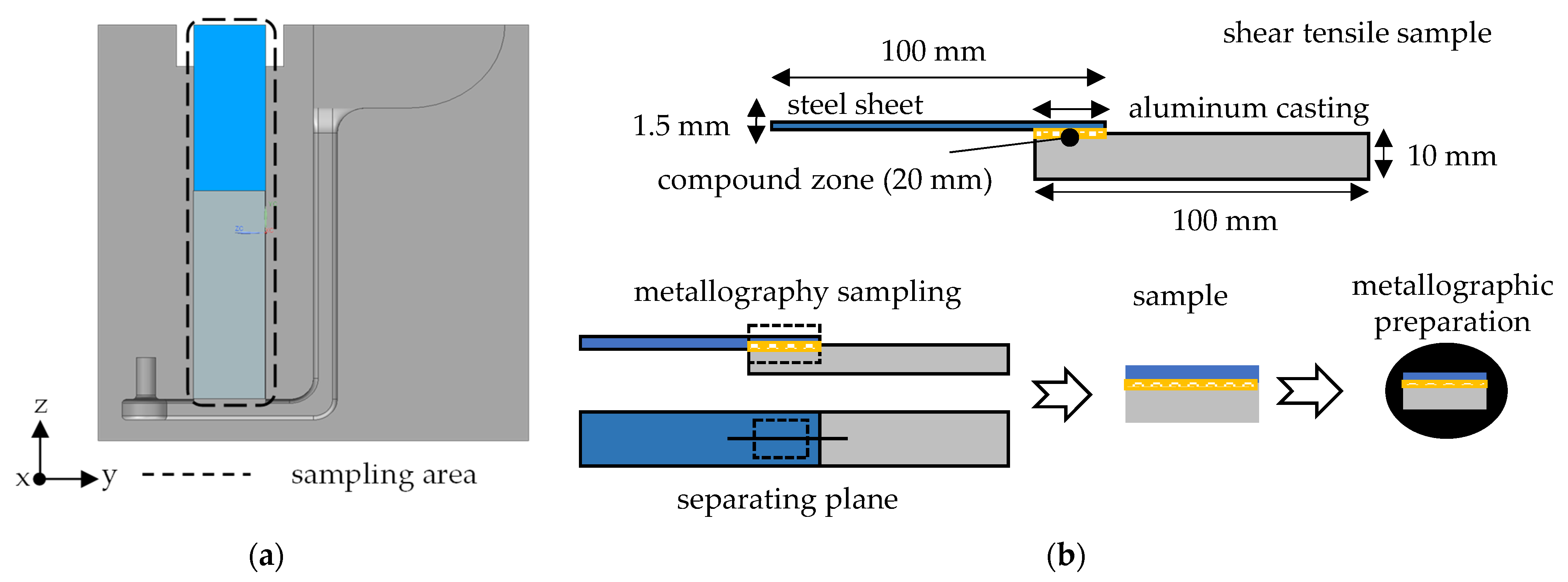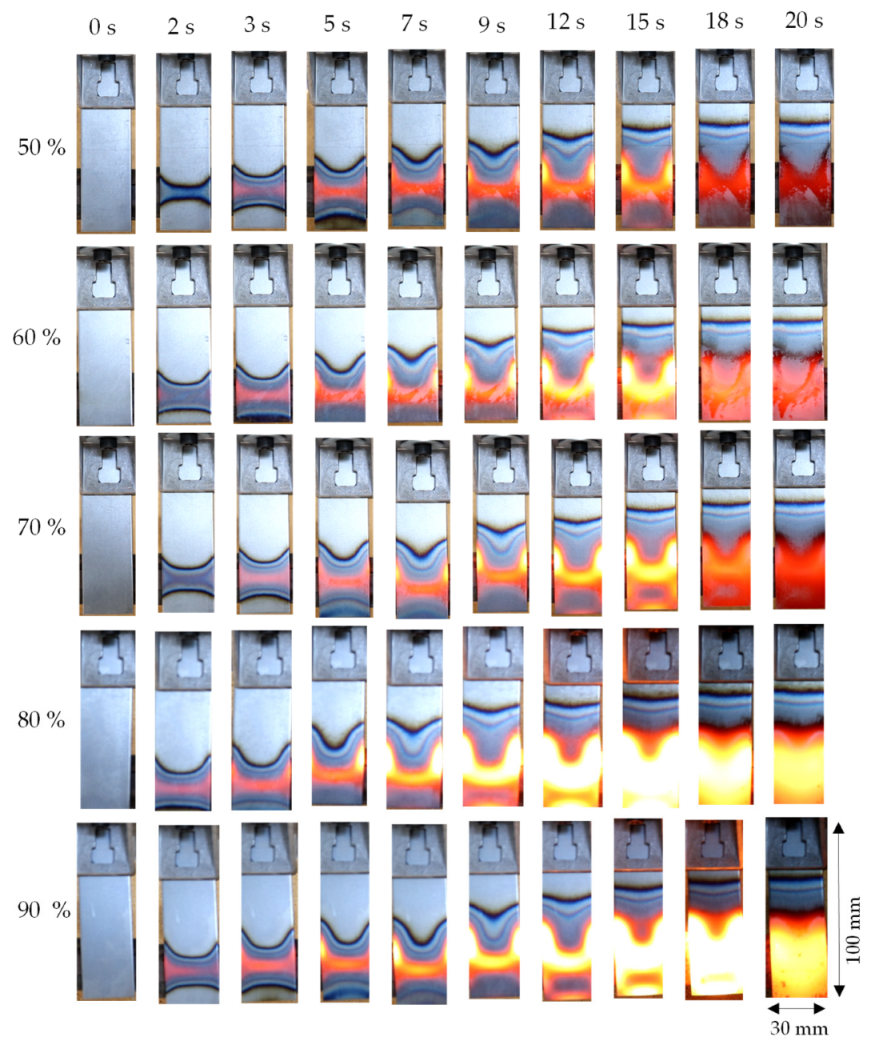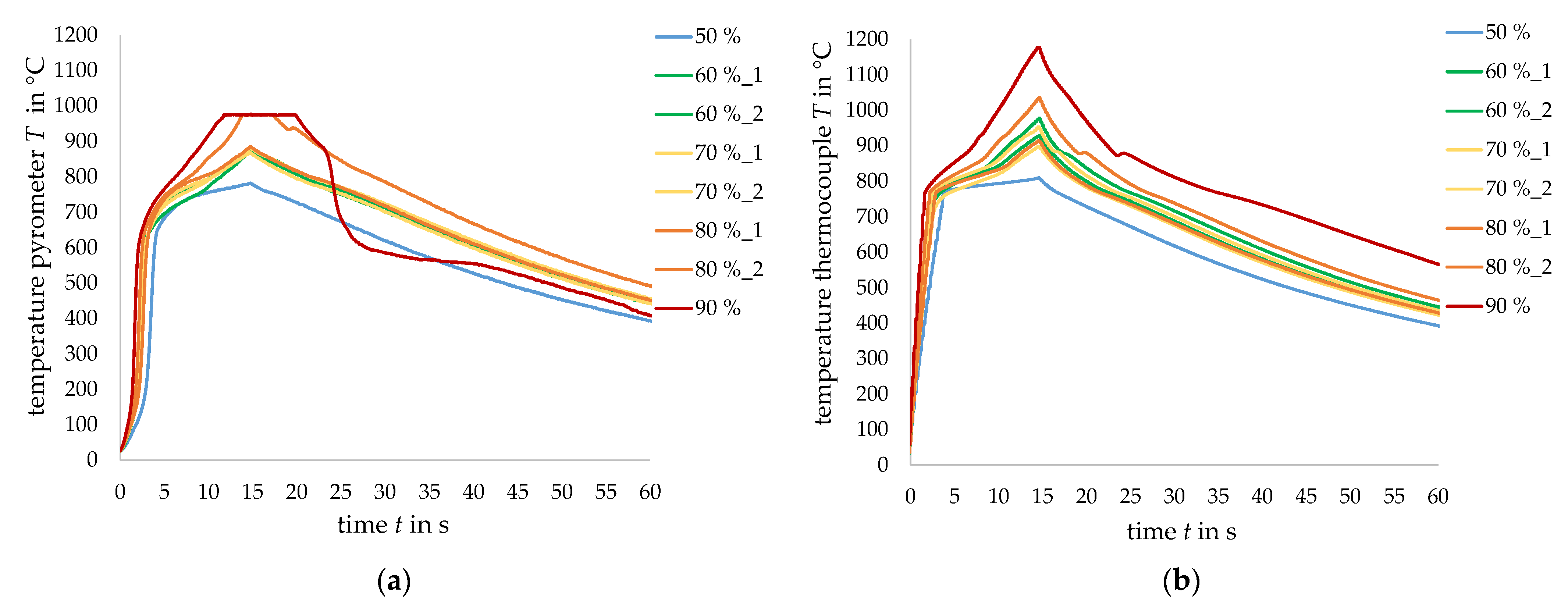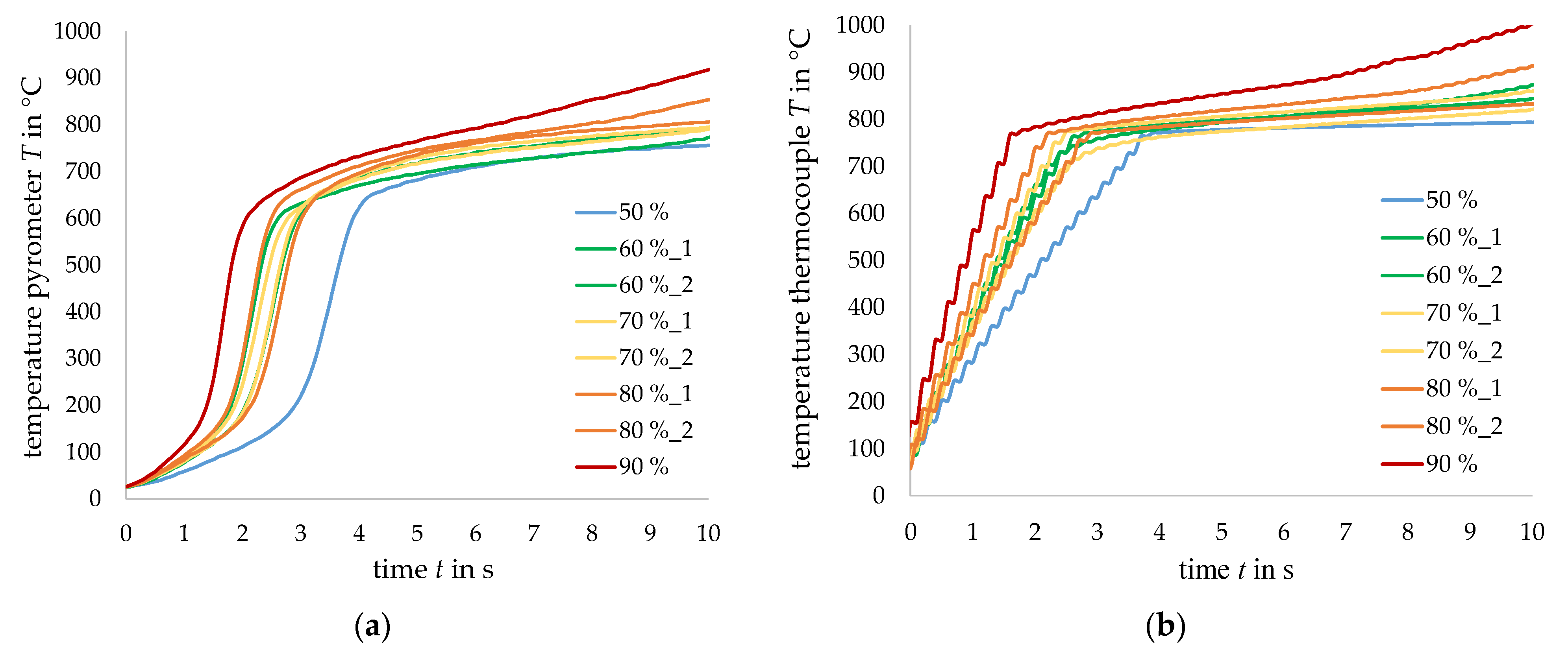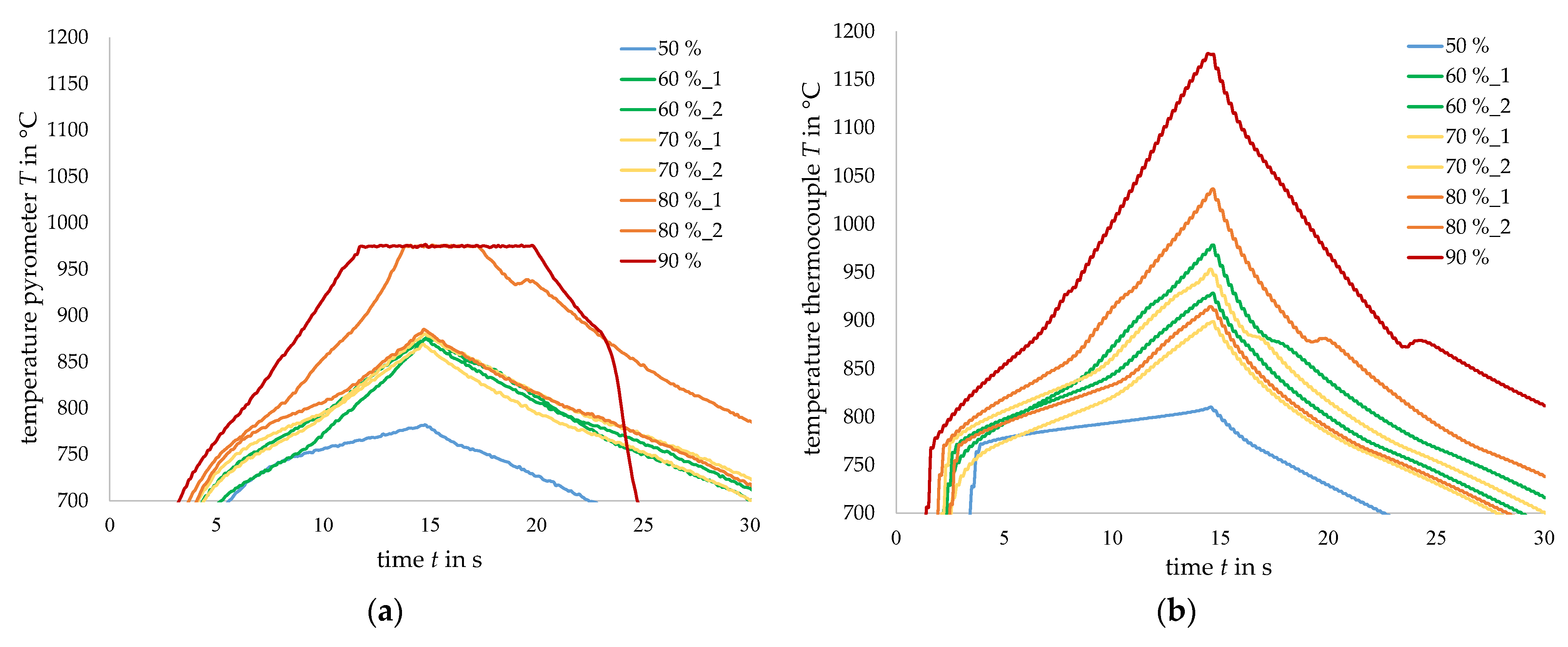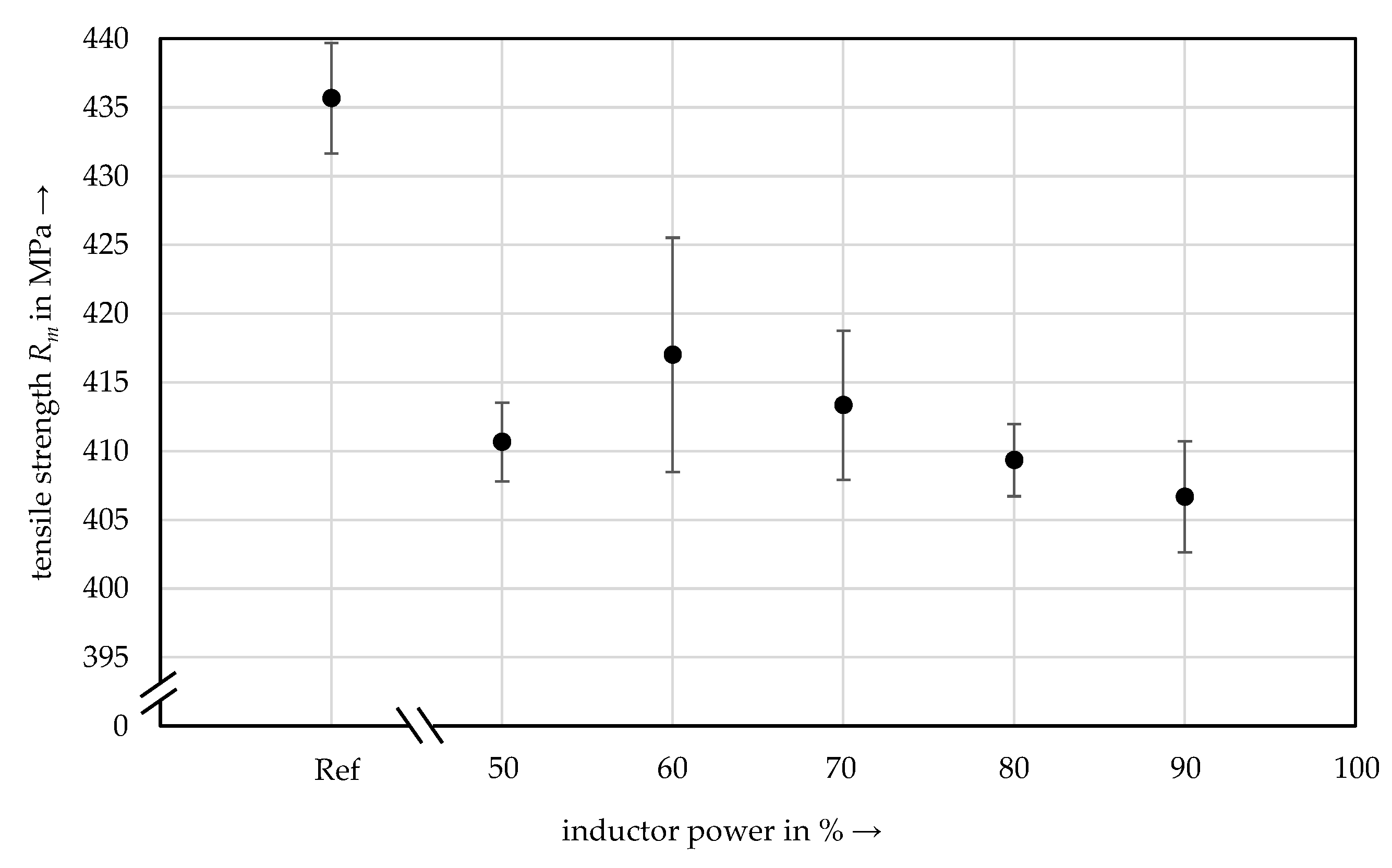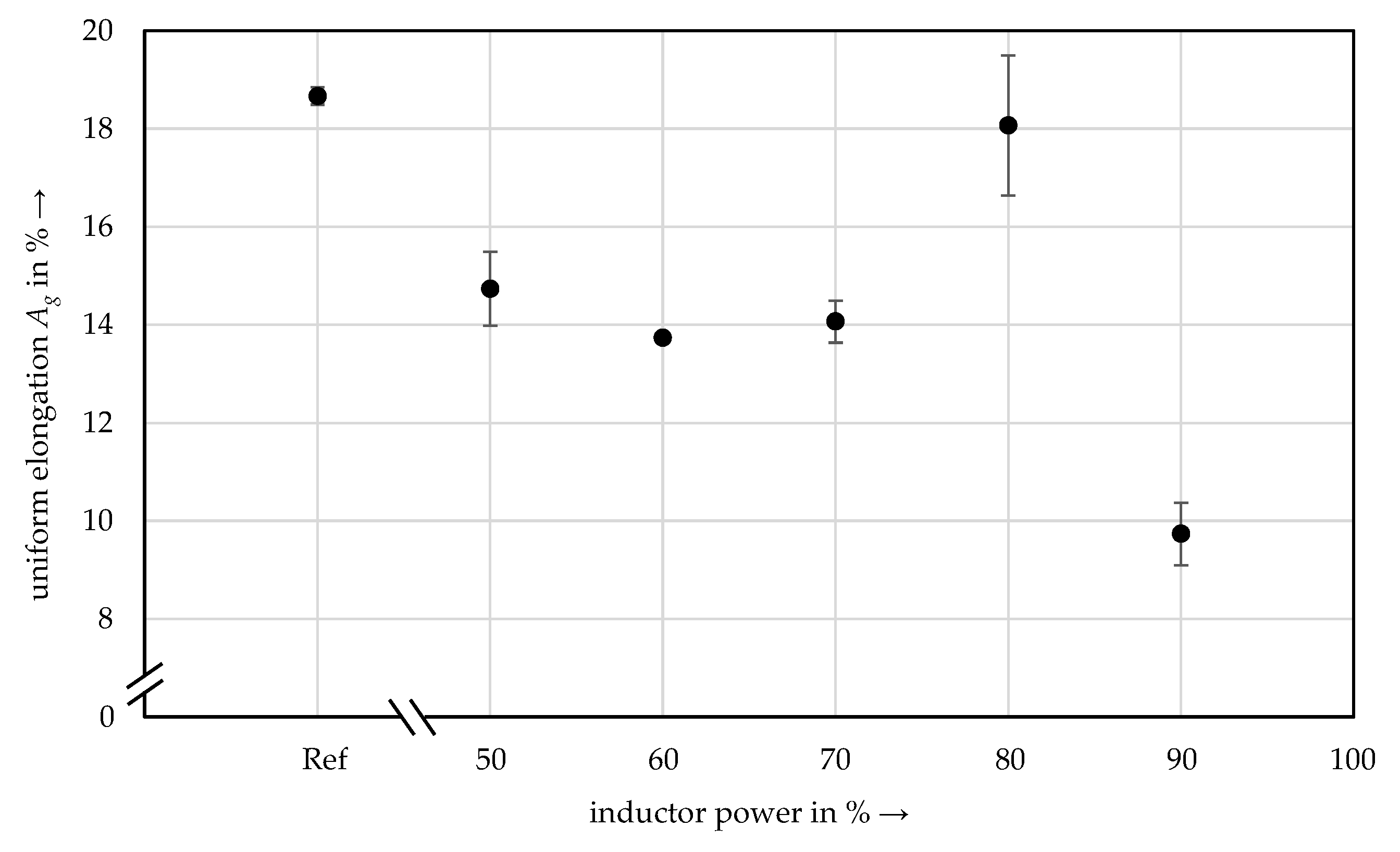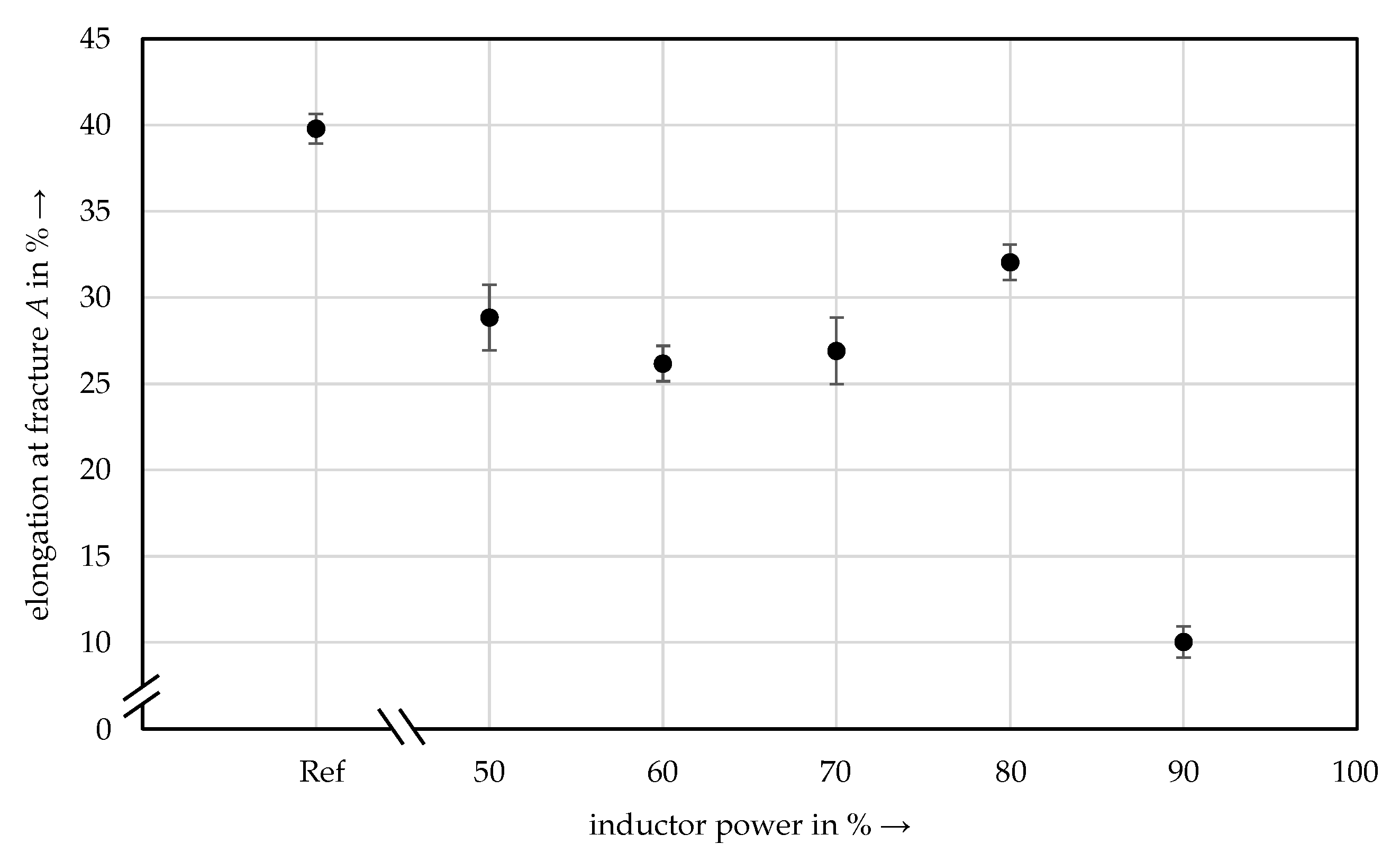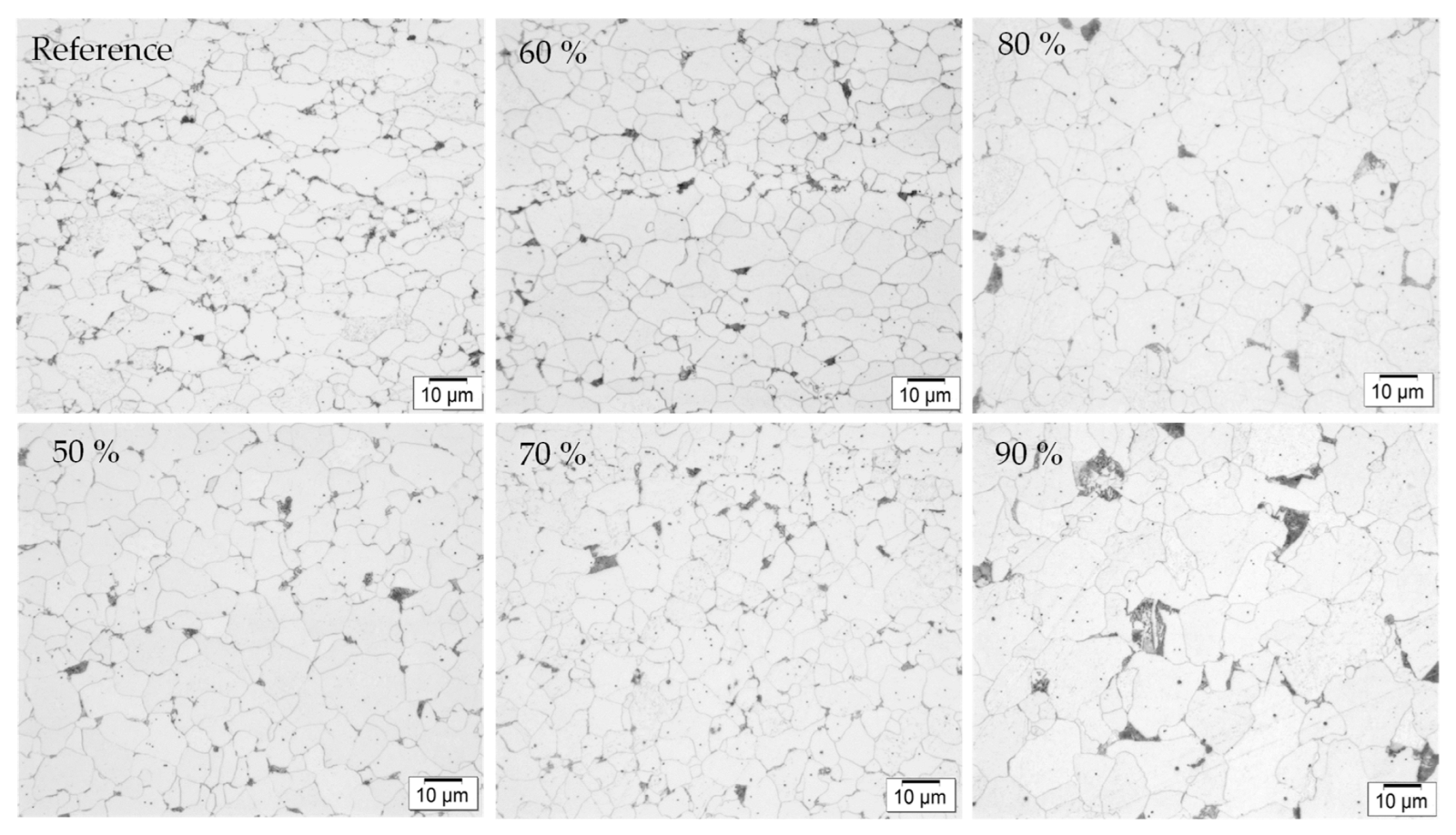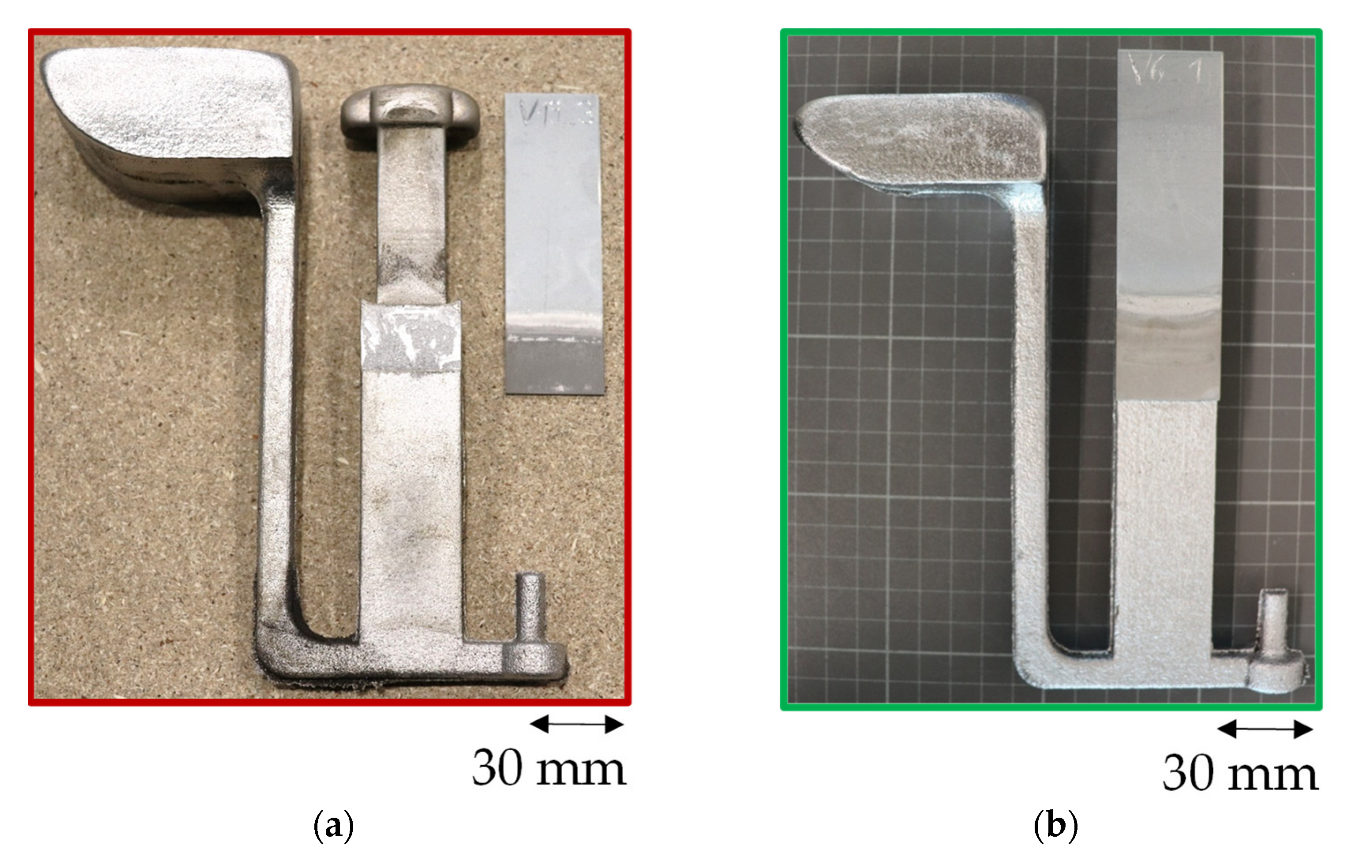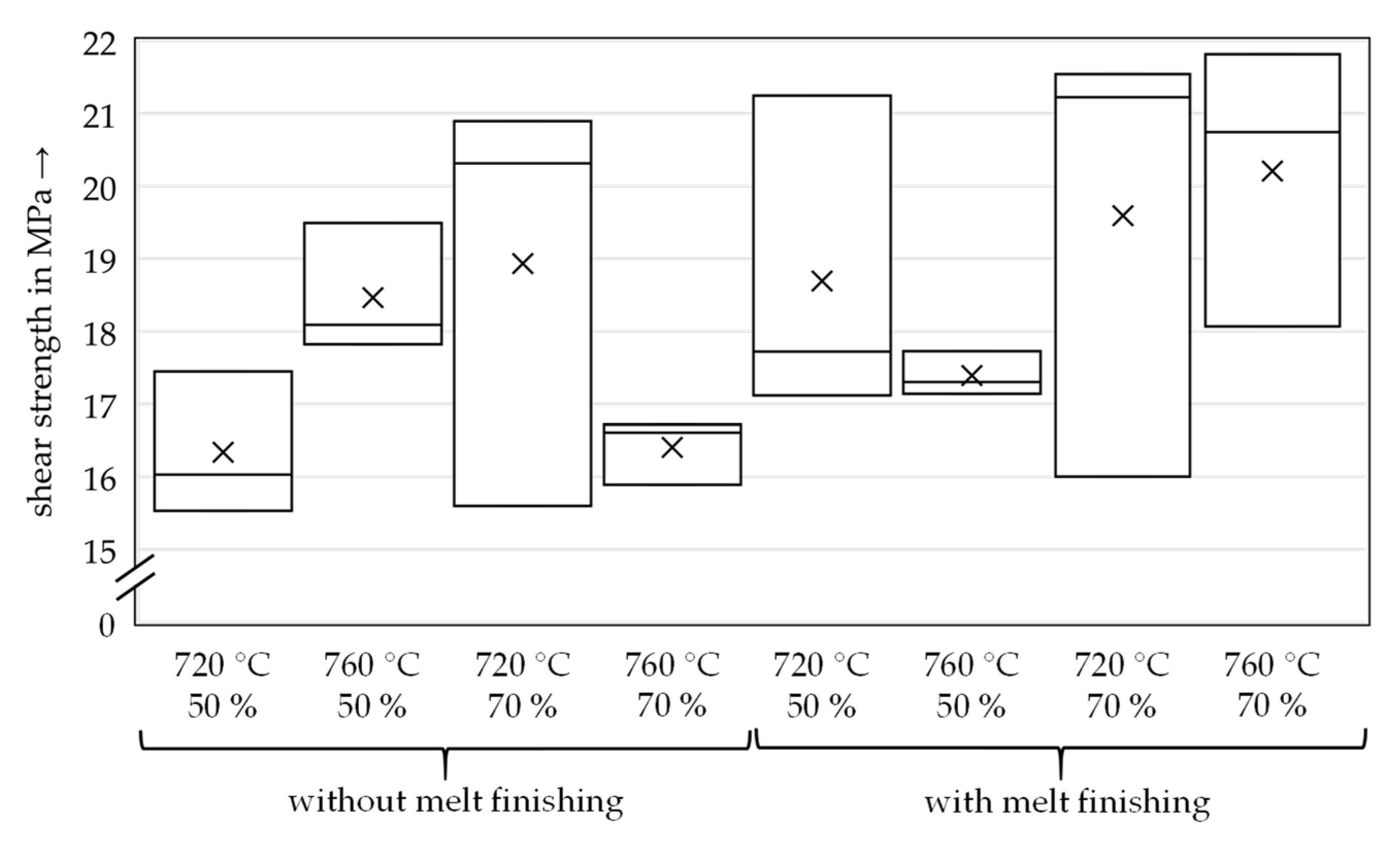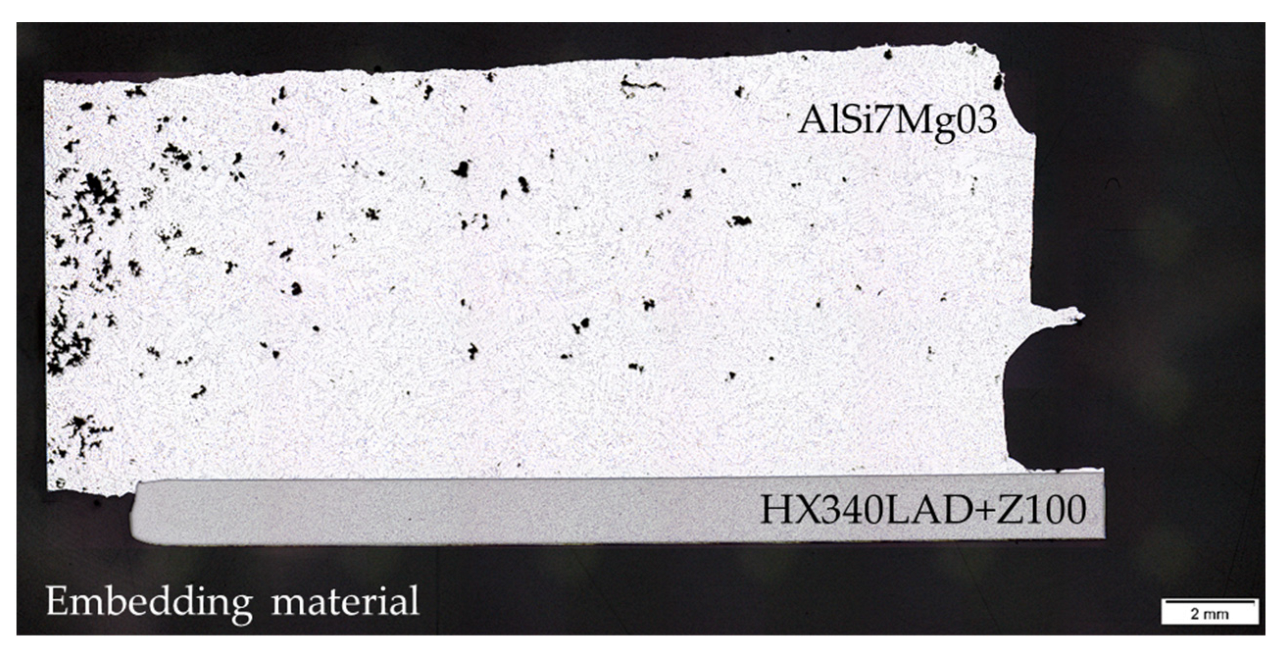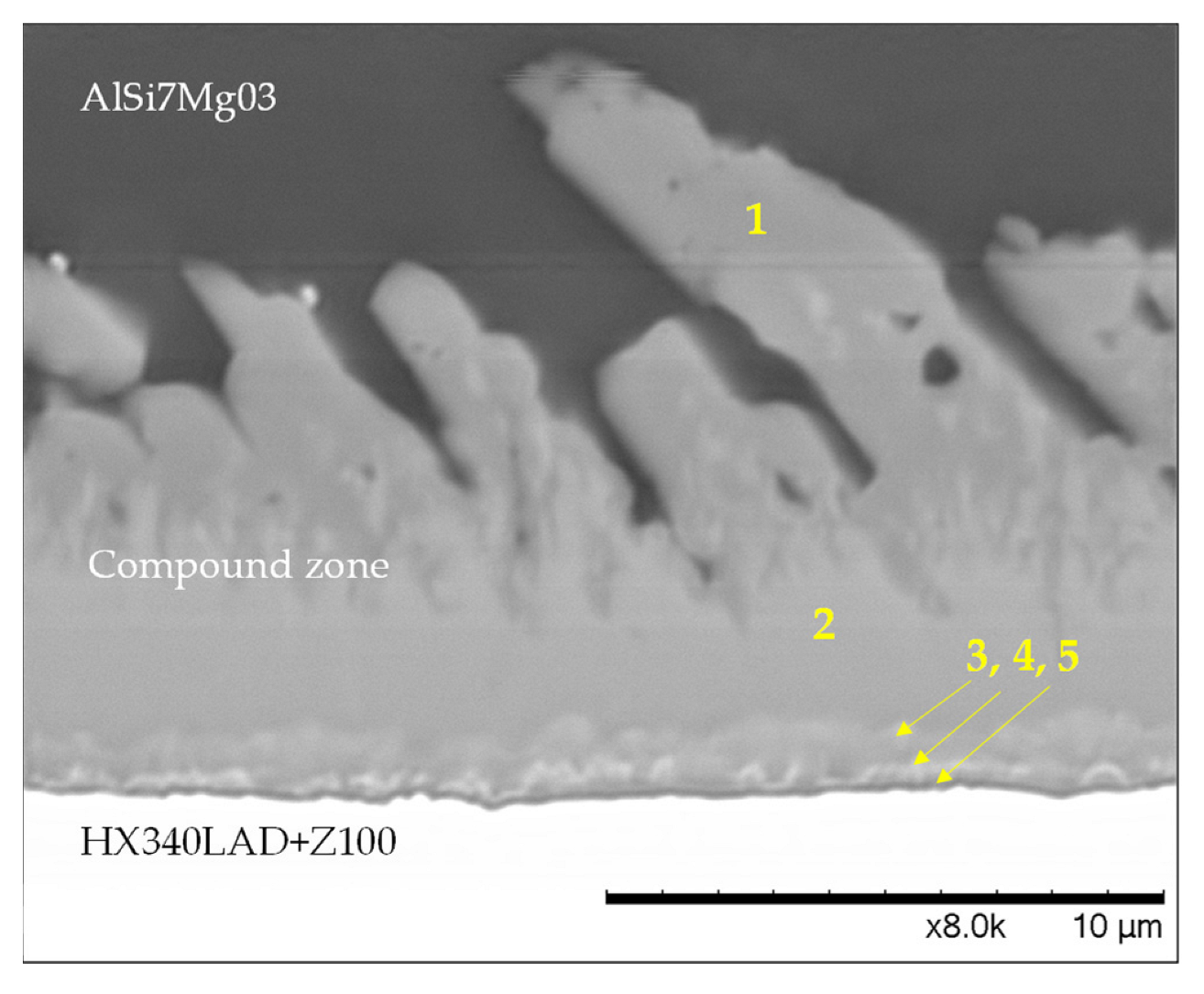1. Introduction
By combining different materials within a component, the individual material properties can be used in a targeted manner. Today, joining processes such as welding or glueing are used. With compound casting technology, the number of process steps can be reduced, as the joining operations can be integrated directly into the process [
1]. Due to the increasing trend of multi-material design (MMD) in the automotive industry [
2], combining two different materials, like cast aluminum and sheet steel, is particularly interesting for lightweight design.
Dezellus et al. displayed that oxide layers act as wetting barriers and inhibit the formation of a metallurgical bond [
3]. Therefore coatings are essential to create a defect-free continuous metallurgical bond [
4]. Various studies on producing aluminum/steel bimetals through compound casting have been performed in recent years. The main focus of these studies was to improve metallurgical bonding through coatings: [
5,
6,
7,
8,
9,
10].
Bakke et al. [
5] investigated the compound casting process using zinc-coated steel pipes (ST37) and the casting alloy AlSi
7Mg
0.3. The phases Al
4.5FeSi (β) and Al
4Fe
1.7Si were detected. The zinc layer dissolved entirely upon the impact of the Al melt. As ZnFe phases were formed during the piece galvanising process, the local Fe content of the melt increased. The absence of the Al
5Fe
2 and the Al
3Fe phase is attributed to insufficient time at elevated temperatures. The morphology of the β-phase has, according to Bakke et al., a significant influence on the mechanical properties. The sharp-edged phase boundaries lead to local stress peaks and promote crack initiation.
Within the scope of further investigations, Bakke et al. [
6] produced a material bond without preheating the inserts using a structural steel piece (S235JR) as the insert material. However, these were steel pipes onto which the casting material was shrunk. Consequently, the bonding improved significantly, and intermetallic phases could form.
In another study, Bakke et al. used tin-coated steel tubes (S235JR) and AlSi
7Mg
0.3 as casting material. The phases Al
5Fe
2 (η), Al
4Fe
1.7Si, Al
7.4Fe
2Si (α) and Al
4.5FeSi were detected starting from the steel to the cast material. The average thickness of the compound zone was 12 µm. As with the zinc coating, the tin layer was completely dissolved in the melt. The different phases in the BSE images (backscattered electrons) can be clearly seen from their contrasts. A peritectic reaction possibly formed the α-phase during the cooling process [
7].
The investigation by Shin et al. focused on the influence of previous sandblasting treatment of the steel inserts. Nevertheless, the results of the zinc-coated inserts that were not sandblasted can be used as a reference. Shin et al. found the Al
13Fe
4, Al
8Fe
2Si and β phases and suggested that the latter phases originated from peritectic reactions. They see why the η-phase was not detectable in the compound zone, mainly in the short time at strongly elevated temperatures and the high silicon content. In particular, it is assumed that the η-phase in other publications in which it was detected could already have been formed during the coating process and is, therefore, not a product of the compound casting process [
8].
Z. Bao et al. investigated aluminum/steel compound formation using electroless nickel and a heat preservation device at a temperature of 760 °C. Good metallurgical bonding is formed between liquid aluminum (ZL102) and nickel-plated heat resistant steel utilizing diffusion, forming an intermediate layer. The phase composition of the intermediate layer is, according to the authors, mainly α-Al, α-Fe, Al
5Fe
2, Al
5FeSi and Al
8Fe
2Si, but the contents of Al
5Fe
2, Al
8Fe
2Si and Al
5FeSi are quite small. The phase composition near the aluminum side is Al
8Fe
2Si, while the phase composition near the nickel-plated steel side is Al
5Fe
2 [
9].
Fang et al. used an AlSi coating for steel/Al compound casting. This led to a failure with ductile fraction, but the shear tensile strength was only 7.7 MPa due to incomplete bonding [
10].
However, creating metallic continuity requires several measures that must be considered in compound casting. These include the preheating of the insert, the provision of a protective gas atmosphere and the use of coated inserts. This work investigates a new method to produce hybrid components from cast aluminum and sheet steel in a 3D sand casting process using an inductive heating system and how different process parameters affect the mechanical properties and microstructure of the joints.
The casting material used is AlSi7Mg0.3, the sheet steel used is HC340LA without coating, and HX340LAD+Z100MBO with a zinc coating (7 µm) is used as insert material. The surface of some coated samples underwent laser surface ablation cutting to investigate the potential for improving the compound bonding by enhancing the surface area and creating microform-locking. The steel sheet is integrated into a vertically divided 3D-printed sand mould. An inductive heating system is implemented into the sand mould in the area of the compound zone. Parallel to the heating process of the sheet, the liquid aluminum is poured into the sand mould. Shear tensile test samples are produced and investigated through shear tensile testing and microstructural investigations.
4. Discussion
The results of the heating behaviour of induction-heated steel sheets show that the sheet substrate temperatures with a power of 50% and 90% differ significantly from those with 60%, 70% and 80%. The flatter temperature bend after the steep temperature rise at the beginning is due to the reach of the Curie temperature resulting in the loss of the magnetic properties,
Figure 7a,b. The inductor powers 60%, 70% and 80% showing a non-linear heating behaviour within the heating duration of 15 s. However, longer heating times have no practical relevance due to the strength-reducing effect on the sheet (see results in
Section 3.2). There are several reasons against a longer induction heating time: One is the coarsening of the grains in the ferrite, and another is the dissolution of precipitates, especially with high inductor powers. At 50% induction power, it would be conceivable to heat longer without significant consequences due to the thermal stability of the precipitates. At 90% induction power, austenitization is accelerated and partial dissolution of precipitates may occur. Therefore, the high induction powers could be more problematic.
Comparing the temperature measurement methods has shown that the temperature measured using a thermocouple provides probably more precise temperature values than the pyrometer measurement, especially in the first 5 to 7 s of the heating period. The deviation of the pyrometer resulted from the emission coefficient ε, which was set to 0.62 during the measurement. However, the emission coefficient is strongly temperature-dependent. With increasing heating time, the pyrometer measurement converged against the thermocouple measurement. The direct coupling of the thermocouple ensured good heat conduction, which made it possible to record more precisely measured values.
As expected, the mechanical properties of the induction-heated steel sheets decrease. However, the overall loss of strength due to the induction heating is low.
The results of the casting trials show the necessity of preheating the coated sheet metal inserts to achieve good material bonding in 3D sand casting. Purely material-bonded compound specimens can be produced. Considering the sheet and casting temperature in total, 670 °C to 950 °C are reached at the compound zone within 15 s depending on the casting temperature and induction power combination. The temperature range and heating time are suitable to produce a sufficient material bond.
The shear tensile tests show that strengths between 15 MPa and 22 MPa are achieved. The influence of the parameter combination is insignificant due to the small sample size. Further research is needed to determine a significant influencing factor, for example, through a higher number of samples or increasing the inductor power from 70% to 90%. Samples without induction heating could not be tested since no bonding resulted.
Higher strengths were achieved compared to the study [
10] with 7.7 MPa and similar sample geometry but with preheating the insert via plaster casting. However, the fracture behaviour was ductile compared to the present results due to the AlSi coating. The further investigated sand casting process did not produce a material bond. The same coating was investigated in high-pressure die casting using the casting alloy AlSi9MgMn [
12]. Here, an average shear tensile strength of 11.3 MPa was achieved when the insert was preheated to 300 °C and showed ductile fracture behaviour. For comparison, tests were carried out with electro-galvanized zinc-coated hot rolled complex phase CPW 800 steel. Without preheating and a casting temperature of 685 °C, the results showed an average shear strength of 14.3 MPa. The same with a casting temperature of 750 °C resulted in average shear strength of 15.1 MPa. With preheating to 200 °C and a casting temperature of 750 °C, the average shear strength increased up to 18.3 MPa. The author states that the strength increase results from preheating the inserters. However, it needs to be clarified whether this is within the standard deviation. Compared to the Al-Si coating the fracture behaviour was brittle. Influencing the fracture behaviour of the aluminum/steel compound castings was not objective and should be investigated in future work. The investigated method in this study shows that comparable strengths to those obtained in high-pressure die casting can be produced despite different process characteristics. A compound could only be generated via inductive preheating of the coated inserts since no preheating is possible through the sand mould. The shear tensile specimens fabricated in [
13] from gravity die casting showed an average shear tensile strength of 6 MPa. A bearing alloy Al12Sn4Si1Cu was used with a tin-coated carbon steel insert. The casting temperature was 720 °C, and sheet preheating via the metal mould was 350 °C. The results suggest brittle fracture behaviour. The shear strengths achieved in the present study are significantly higher.
In a study by Senff et al., steel/aluminum shear tensile specimens were machined with friction stir welding (FSW) in the area of the compound zone after the high pressure die-casting process. The FSW increased the strength of the joint from 15 MPa (without FSW) to around 40 MPa (with FSW on both sides) of the joint [
14]. The FSW process could increase the strength of steel/aluminum joints from sand casting.
Laser engraving did not improve the shear strength due to the crack initiation by the engravings into the casting and reducing wettability. The casting did not fill the cavities, so microform-locking could not be achieved. For improvement, the sheet surface must be structured before applying the coating to utilize the strength-enhancing potential of the microform-locking. The reverse of the process steps would improve the wettability of the aluminum melt and, thus, the bonding effect through microform-locking. Casting around the sheet could also benefit microform locking during solidification because of the shrink fitting, resulting in a better performance.
Author Contributions
Conceptualization, C.L.; methodology, C.L. and M.G. (Martin Guggemos); formal analysis, M.G. (Martin Guggemos), C.L. and M.G. (Maximilian Gruber); investigation, M.G. (Martin Guggemos), C.L. and M.G. (Maximilian Gruber); resources, L.M. (Lukas Mayr), L.M. (Lorenz Maier), M.G. (Maximilian Gruber) and T.W.; data curation, M.G. (Martin Guggemos), C.L. and M.G. (Maximilian Gruber); writing—original draft preparation, C.L.; writing—review and editing, M.G. (Martin Guggemos), M.G. (Maximilian Gruber), L.M. (Lorenz Maier) and L.M. (Lukas Mayr); visualization, C.L. and M.G. (Martin Guggemos); supervision, W.V. and D.G.; All authors have read and agreed to the published version of the manuscript.
Funding
This research received no external funding.
Data Availability Statement
The data presented are available on request from the corresponding author. The data are not publicly available since they are part of an ongoing study.
Conflicts of Interest
The authors declare no conflict of interest.
References
- Clausen, J. Hybrid and Compound Casting. Short Processing Times Thanks to Hybrid Castings—Ideal for Lightweight Construction. Available online: https://www.ifam.fraunhofer.de/de/technologien/hybridguss.html (accessed on 24 November 2022).
- Czerwinski, F. Current Trends in Automotive Lightweighting Strategies and Materials. Materials 2021, 14, 6631. [Google Scholar] [CrossRef] [PubMed]
- Olivier Dezellus, N. Eustathopoulos. Fundamental issues of reactive wetting by liquid metals. J. Mater. Sci. 2010, 45, 4256–4264. [Google Scholar] [CrossRef]
- Soderhjelm, C. Multi-Material Metal Casting: Metallurgically Bonding Aluminum to Ferrous Inserts; Worcester Polytechnic Institute: Worcester, MA, USA, 2017; Available online: https://digital.wpi.edu/show/j6731396q (accessed on 6 December 2022).
- Bakke, A.O.; Arnberg, L.; Løland, J.-O.; Jørgensen, S.; Kvinge, J.; Li, Y. Formation and evolution of the interfacial structure in al/steel compound castings during solidification and heat treatment. J. Alloys Compd. 2020, 849, 156685. [Google Scholar] [CrossRef]
- Bakke, A.O.; Nordmark, A.; Arnberg, L.; Li, Y. Interfacial microstructure formation in A356/steel compound castings using metal coating. MATEC Web Conf. 2020, 326, 6005. [Google Scholar] [CrossRef]
- Bakke, A.O.; Nordmark, A.; Arnberg, L.; Li, Y. Sn-Aided Joining of Cast Aluminum and Steel Through a Compound Casting Process. Met. Mater. Trans. B 2021, 53, 60–70. [Google Scholar] [CrossRef]
- Shin, J.; Kim, T.; Lim, K.; Cho, H.; Yang, D.; Jeong, C.; Yi, S. Effects of steel type and sandblasting pretreatment on the solid-liquid compound casting characteristics of zinc-coated steel/aluminum bimetals. J. Alloys Compd. 2018, 778, 170–185. [Google Scholar] [CrossRef]
- Bao, Z.; Wang, S.; Han, R.; Tang, M.; Zhao, C.; Zhang, H. Microstructure and mechanical properties of aluminum/steel bimetal using compound casting with electroless nickel plating. Mater. Res. Express 2021, 8, 016517. [Google Scholar] [CrossRef]
- Fang, X.; Gundlach, J.; Schipperges, J.-J.; Jiang, X. On the Steel–Aluminum Hybrid Casting by Sand Casting. J. Mater. Eng. Perform. 2018, 27, 6415–6425. [Google Scholar] [CrossRef]
- Kleiber Infrared. Emissivity Table. Available online: https://www.kleiberinfrared.com/index.php/de/amanwendungen/emissionsgrade.html (accessed on 5 January 2023).
- Fang, X. Evaluation of Coating Systems for Steel Aluminum Hybrid Casting. J. Mater. Sci. Eng. A 2017, 7, 51–67. [Google Scholar] [CrossRef]
- Ramadan, M.; Subhani, T.; Rajhi, W.; Ayadi, B.; Al-Ghamdi, A.S. A Novel Technique to Prepare Cast Al-bearing alloy/Wrought Steel Bimetallic Specimen for Interfacial Shear Strength. Int. J. Eng. Adv. Technol. 2020, 9, 3322–3326. [Google Scholar] [CrossRef]
- Senff, M.; Volk, W. Hybrid joining of cast aluminum and steel by compound casting and friction stir welding. Prod. Eng. 2023. [Google Scholar] [CrossRef]
Figure 1.
Schematic Illustration of the Temperature Test Rig.
Figure 2.
Illustration of Laser-based Surface Structuring of HX340LAD+Z100 Sheet Steel.
Figure 3.
(a) Cut View and Inductor Position. (b) Casting System. (c) Top View. (d) Overall View.
Figure 4.
(a) Sampling Area of the Casting. (b) Dimensions of Shear Tensile Specimen and Metallographic Preparation.
Figure 5.
Qualitative Heating Behaviour of Induction-Heated Steel Sheets without Coating.
Figure 6.
Overview of the Temperature-Time Curve: (a) Using a Pyrometer during Induction Heating of the Steel Sheet. (b) Using a Thermocouple during Induction Heating of the Steel Sheet.
Figure 7.
Enlargement of the Graphs in
Figure 6 in the initial part: (
a) Pyrometer Measurement. (
b) Thermocouple Measurement.
Figure 8.
Expansion of the Graphs in
Figure 6 in the Maximum Temperature Zone: (
a) Pyrometer Measurement. (
b) Thermocouple Measurement.
Figure 9.
Tensile Strength Rm of Inductive Heated Tensile Specimen.
Figure 10.
Uniform Elongation Ag of Inductive Heated Tensile Specimen.
Figure 11.
Elongation at Fracture A in % of Inductive Heated Tensile Specimen.
Figure 12.
Microstructural Changes due to Inductive Heating on Flat Tensile Specimens (1000× magnification).
Figure 13.
Representative Results from the Casting Trials with Band Hot-Dip Zinc-Coated Sheet Metal HX340LAD+Z100. (a) Without Induction, no sufficient Material Bonding. (b) With Induction, a Material Bond occurred.
Figure 14.
Measured Aluminum Casting Temperature in the Area of the Compound Zone during the Casting Process.
Figure 15.
Shear Tensile Strength of the Aluminum/Steel Compound Specimens.
Figure 16.
Overview Image of an Aluminum/Steel Compound Casting Sample.
Figure 17.
Detail of an Aluminum/Steel Compound Casting Sample with a previous Laser Engraving of the Sheet Surface.
Figure 18.
SEM Image of an Aluminum/Steel Compound Zone with a Magnification of 8000×. Five Intermetallic Phases are visible. Phase 1: Al4.5FeSi, Phase 2: Al7Fe2Si, Phase 3 to 5 cannot be determined with certainty.
| Disclaimer/Publisher’s Note: The statements, opinions and data contained in all publications are solely those of the individual author(s) and contributor(s) and not of MDPI and/or the editor(s). MDPI and/or the editor(s) disclaim responsibility for any injury to people or property resulting from any ideas, methods, instructions or products referred to in the content. |
© 2023 by the authors. Licensee MDPI, Basel, Switzerland. This article is an open access article distributed under the terms and conditions of the Creative Commons Attribution (CC BY) license (https://creativecommons.org/licenses/by/4.0/).

